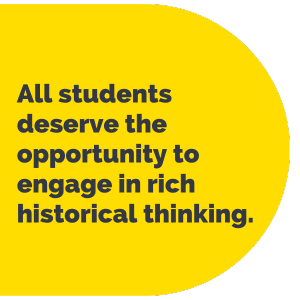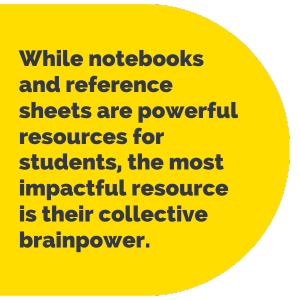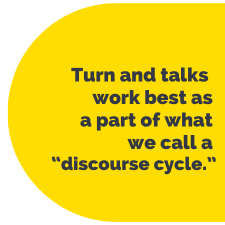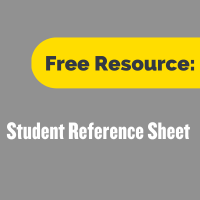历史教师希望学生深入接触复杂的原始资料。然而,有些教师除了担心学生的阅读水平外,还可能因为这些课文的复杂性而不愿布置这些课文。但是,所有学生都应该有机会参与丰富的历史思考。通过有策略地安排知识点,同时有意识地组织资源,我们可以让学生做好分析资料的准备,从而保持较高的认知要求和较低的脚手架。

在本书的第四部分、 创造历史:初高中历史教学实用指南今天,我们来到斯科特-克恩(Scott Kern)的美国历史高级预科班,看看这些动作的实际效果。
跌落知识
在当天的探究活动中,斯科特改编了斯坦福历史教育集团的课程 "家园罢工为何演变成暴力事件?* 为成功回答这一问题,学生将分析两份原始资料文件:社会主义活动家艾玛-戈德曼的自传节选和报纸对工厂经理亨利-C-弗里克的采访。
斯科特知道学生们有足够的历史背景来理解这两段资料的要点,但他预计学生们可能会在某个地方卡壳。在观看下面的视频时,请思考:他是如何让学生做好准备迎接挑战的?
通过在学生需要之前定义一个关键术语(平克顿侦探),斯科特为他们提供了所需的信息,使他们能够自己打开资料来源。我们称这种做法为 "丢弃知识"(drop knowledge),你可能会认为这是一种 "前置"(frontloading)。前置式教学通常是在课程开始时,在学生需要之前为他们提供关键定义和/或历史背景。此举有助于学生独立浏览复杂的资料来源,在本案例中,就是帮助学生理解关于家园罢工的不同观点。"前置 "通常是由教师主导的举措。尝试下面的步骤,让学生掌握更多的权力。
学生笔记
正如您在视频中看到的,斯科特的学生不是被动的聆听者,而是积极的学习者。在他的迷你课堂上,学生们用康奈尔笔记的形式记录下了他们不断加深的理解。这些笔记是一种重要的资源,学生可以利用它们将原始资料文件置于适当的历史背景中。在笔记中,学生可以回答文件产生时发生了什么这一关键问题,并解释其预期目的和/或受众。
学生们定期用新信息更新笔记,并对笔记的质量和整洁程度引以为豪。为了保持较高的反馈水平,斯科特会定期收集笔记的条理性和完整性并进行评分。
有条理的笔记本为连贯地讲述过去奠定了基础。下面的资料使其更加完善。
学生参考表
 斯科特班上的每个学生都有一张参考表,通常称为知识组织器,上面记录了与工业革命相关的关键信息(日期、定义、人物)。在整个单元的学习过程中,这张单页资料是一个重要的学习支架。学生用它来回答基本问题,这样就能解放他们的思维,解决更深层次的问题,也让斯科特有更多的时间来促进讨论和指导理解。参考表还能帮助学生在一个单元中优先学习最重要的知识,并随着时间的推移将这些知识编码到他们的长期记忆中。我们为您提供了一份参考表样本、 这里.(有关如何利用知识检索来提高学习效率的更多信息,请阅读本书第 2 部分。 创造历史).
斯科特班上的每个学生都有一张参考表,通常称为知识组织器,上面记录了与工业革命相关的关键信息(日期、定义、人物)。在整个单元的学习过程中,这张单页资料是一个重要的学习支架。学生用它来回答基本问题,这样就能解放他们的思维,解决更深层次的问题,也让斯科特有更多的时间来促进讨论和指导理解。参考表还能帮助学生在一个单元中优先学习最重要的知识,并随着时间的推移将这些知识编码到他们的长期记忆中。我们为您提供了一份参考表样本、 这里.(有关如何利用知识检索来提高学习效率的更多信息,请阅读本书第 2 部分。 创造历史).
在斯科特的课堂上,笔记本和参考资料是学生的有力资源,但最有影响力的资源或许是他们的集体脑力。为此,斯科特采用了一种屡试不爽的方法:轮流发言。
转身与交谈
斯科特没有把学生的谈话留到讲座或课堂的最后,而是有策略地在整节课中穿插 "转而谈"。这让学生有更多机会了解新的证据,并在同伴的帮助下推动有限的思维。这种合作式的感性认识,让学生明白了学习历史的一个关键点: 我们才能更好地共同理解过去。学生在合作中积极检查和评估观点和证据,并澄清误解,从而获得更加细致入微的理解。
我们才能更好地共同理解过去。学生在合作中积极检查和评估观点和证据,并澄清误解,从而获得更加细致入微的理解。
如果你不确定在一堂课中将 "转身说话 "放在什么位置,请使用以下指导:
翻转和谈话几乎可以在一堂课的任何时候使用,但作为我们所说的 "话语循环 "的一部分,效果最好。(请参阅 创造历史 了解更多详情)。以下是该周期的浓缩版本:
- 介绍提示:这可以是中心历史问题或相关问题。
- 让学生独立检查、阅读并批注证据。
- 请学生轮流发言,交流想法和问题。
- 在巡回倾听并参与对话之后,召集小组成员讨论会议室中的想法。
- 在本课的剩余时间里,根据需要重复这一循环。
抛开知识点、记笔记、参考资料和翻转课堂等简单而有力的方法,既能帮助学生理解过去的意义,又不会淡化知识的来源。如需了解更多关于如何增加学生获取知识机会的策略,请阅读本书第 2-4 部分。 创造历史.
*1892年,宾夕法尼亚州霍姆斯特德:钢铁工人与卡内基钢铁厂经理亨利-弗里克的工资谈判破裂,工会工人宣布罢工,并包围了工厂。作为回应,亨利-弗里克派出一支武装民兵重新进入工厂。不久便发生了枪战。
点击以下链接获取上述资料的 PDF 文件:



